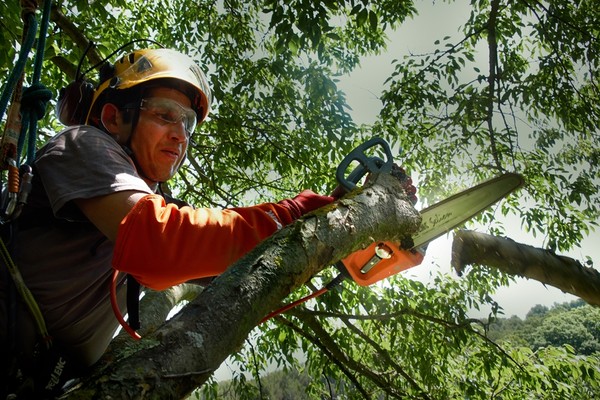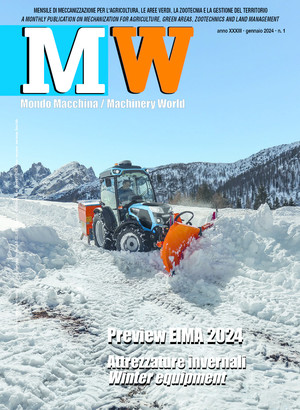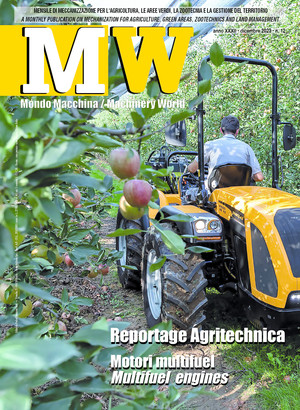
Chainsaws and electric saws, an evolving technology
Chainsaws and power saws are the specific items of equipment for felling trees and pruning and are fundamental for operations and maintenance on wooded lands and green areas. Technological innovations now allow manufacturers to market models which combine maximum efficiency and limited weight along with a substantial reduction of vibrations and noise
Chainsaws and electric power saws by now have replaced the traditional tools used for felling trees, pruning operations and deliming, tools such as saws, axes and hatchets. These machines powered by internal combustion engines for chainsaws or electric motors are no longer used only in forestry but also for gardening and in arboriculture. Their users are not only professionals but also hobbyists. This has come about thanks to the evolution of the technology which has made these machines increasingly lighter and easier to use with safety and comfort for the end-user.
Cutting is done by a saw toothed chain rotating around a guide bar and support, control and running are operated by the handlebar where, or nearby, are the control switches of the machine. The chain in operation must have the correct tension and continuous lubrication to reduce ware of the guide bar. Engine power is transmitted to the chain sprocket via a centrifugal clutch. Thus overall, this is a relatively simple machine but not without risks for the end-user.
Chainsaws
These machines are equipped with an internal combustion engine, usually a single cylinder two stroke engine running on a fuel mix of gasoline oil (2%). They can be differentiated in four distinct classifications, power (kW), length of the bar (m) and weight (kg) as shown in table 1.
This classification is closely linked to the types of predominant use. Simplifying, it can be said that lightweight and medium chainsaws with bar length of no more than 55 cm and weight between 2.5 and 7 kg are used mainly by hobbyists and gardeners for arboricultural operations. Moreover, these machines are especially suitable for operations performed at a certain height off the ground by an operator on a platform or for work involving climbing the tree. The heavy and extra heavy chainsaws equipped with greater power, up to 10 kW and beyond, and weight which can exceed 10 kg, and are clearly used by professionals generally at work in arboriculture or forestry.
The engine, a single cylinder two stroke model, runs at a maximum regime of 14,000 rpm to ensure a blade speed of 15-20 m/s to 25-30 m/s. These engines are air cooled by a fan mounted on the flywheel magnet which supplies electricity to the sparkplug. Other than power (kW), torque value (Nm) is also important as torque is required to win out over the resistance of cutting.
The chainsaw is started by gripping a handle attached to a pull rope wound around the cooling pulley and giving it a sudden pull. The higher power models are equipped with a decompression valve which reduces the force needed to pull the handle. For cold starting, there is a starter which acts on the carburator regulating the quanty of air drawn in and takes the throttle to medium accelleration. The start/stop switch acts on the electrical circuit making it possible to block the current produced by the flywheel magnet. The chain is made up of three types of links which work as the guard link, depth gauge and the cutters. For regulating the tension of the saw chain there is a side tensioner on the chain housing. There is also an oil tank for lubrication identified as such to distinguish it from the fuel tank. In general, the oil pump can be regulated to lubricate the chain in relation to the operations performed. In front of the front handle is a hand guard which activates the chain brake and prevents the sawyer’s hand from contacting the chain and on the rear hand guard is the throttle control lever for accelerating and braking so that acceleration is impeded if the operator’s hand is not firmly gripping this hand guard.
There are special parameters applied to the two hand guards because of their function for protecting the hands of the operator. On some models, these handles can be heated by electrical resistance or recycling exhaust gas.
Electronics have also been introducted for these machines. There is electronic assistence for carburators which make it possible to reduce fuel consumption and emissions. Moreover, electronic management of the engine allows only a single position for starting and conducts a quick and complete diagnosis for troubleshooting if the motor stops or revision is required. Other than electronics for reducing emissions, catalytic mufflers and recourse to alkylated fuel which has a higher octane number and lower content of aromatic compounds compared to traditional gasoline.
The aim is to reduce noise limits of acustic power (LWA) as well as the sound pressure perceived by the ears of the operator (LPA).
For the comfort of the operator, other than lowering the noise level it is also important to reduce vibrations reaching the sawyer’s arm. For this purpose, anti-vibration systms are used, springs, silent blocs, which attenuate the vibrations reaching the handle and facilitate the control of the chainsaw. Trials with a 2.8 kW power chainsaw (55.5 cm3), have demonstrated that recourse to alkylated fuel as opposed to normal mixes reduces VOC (Volatile Organic Compounds) emissions by more than 50% as well as the percentage of CO2 . This is the case for various engine regimes, minimum, medium and maximum, in operations. Also reported was a reduction in noise and vibration levels by a few percentage points (Pessina).
In table 2, examples of the principle characteristics of a medium class chainsaw (3.0-3.5 kW) are reported.
Delimbers must be handled separatly. These are chainsaws mounted on telescopic booms for pruning operations from the ground with a pole which can be extended to the height of 4-5 meters.
These machines are relatively light and can be regulated to intermediate positions, from zero to 90º, and are equipped with engines with power generally less than 1.5 kW. Balance is an important requirement for all chainsaws for the purpose of reducing fatigue as well as for safety.
Electric saws
When an internal combustion engine is replaced by an electric motor the saw becomes an electric saw. The saw can be operated off an electric cable 4-5 meters in length or batteries. The length of the guide bar is 25-35 cm and power comes to 2.5 kW, the equivalent of a 55 cm3 displacement, capable of providing much the same performance as that of a chainsaw of equal power. These saws, however, are lighter, easier to manage and produce less noise and lower vibration levels. Moreover, they require less maintenance and do not produce emissions of VOC, CO2 or particulates. Also these machines have benefited from electronic innovations and those applied to the safety of those powered by international combustion engines.
As regards noise, acustic power and sound pressure on the ears of the operator are below 100 dB(A) and vibrations reaching the handle do not exceed 3 m/s2. A comparison of direct emissions expressed in CO2 equivalence at power of around 2 kW shows that:
- ‑for chainsaws, direct emissions plus those produced by gasoline come to some 4 kg di CO2 eq/h;
- ‑for battery operated electric saws, direct emissions are nill and considering those for the production of electricity for recharging the values come to 30-35 g of CO2 eq/h. If the batteries are charged by solar energy the emissions are, of course, nill.
The innovations brought in in recent years have been applied mainly to electric saws powered by lithium-ion batteries for increasing their performance. New lithium-ion batteries, normally 36 Volt and 3 Ah, are 80% recyclable and have a life of 800 cycles. Recharging time varies from 30-40 minutes to two hours for autonomy of about half a day. This autonomy can be greatly increased with the use of a battery backpack.
The weight of a battery powered electric saw comes to 2-3 kg and the battery weighs about 1 kg. Models with different power specifications and length of guide bar are marketed to meet the various requirements of end-users.
Use and maintenance
For the correct use and maintenance of these machines the end-user must comply with the norms on use and maintenance contained in the instruction manual. Especially for the use of chainsaws equipped with internal combustion engines, the air filter must be changed every 8-10 hours of operation if it is damaged or very dirty; the sparkplug must be checked for distance from the electroids; the carburator filter and the cylinder cooling fins must be cleaned. For chainsaws and electric saws it is important to check the level of librication oil and the chain safety brake and, if necessary, replace it. The chain saw must br sharpened periodically; after sharpening, it must be thoroughly cleaned to eliminate filings and then lubricated in an oil bath.








